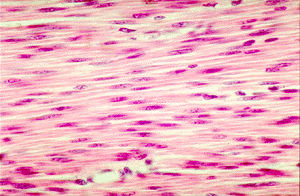smooth muscle

Smooth muscle from a section of small intestine.
Smooth muscle, which is also called unstriated or unstriped muscle, is one of three main types of muscle, the others being skeletal muscle and cardiac muscle. Smooth muscle is muscle over which we have no conscious (voluntary) control. Instead, it is under control of the autonomic nervous system.
Smooth muscle is found mainly in the walls of hollow internal organs such as blood vessels, the gastrointestinal tract, the urinary bladder, and the uterus. It is capable of slow, sustained, and rhythmic contractions such as those needed to push food steadily through the gut (see peristalsis). Smooth muscle cells lie parallel to one another and contract as a single unit, with the impulse to contract being passed to small groups of cells by a single innervating nerve, coordinating with other nerves (see muscle contraction).
A smooth muscle cell is spindle-shaped, tapering to a point at each end, and has a central nucleus. Each cell is about 0.2 millmeters long and about 0.007 millimeters wide.


